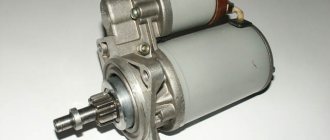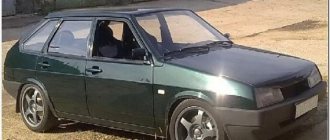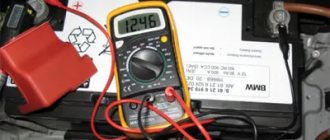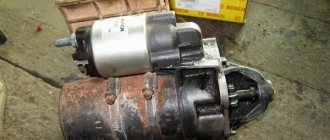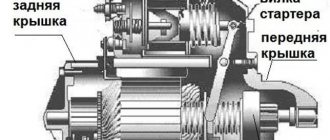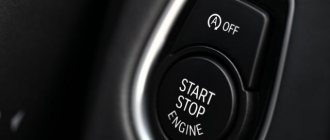- VAZ starter: general concepts
- How is the starter connected?
- Possible causes of problems with the starter
- Useful video
- Finally
The situation when, before the expected trip, the starter of a VAZ 2114 suddenly does not turn, and even in the cold season, for example, is not pleasant, because without a starter the flywheel will not be able to spin the car’s engine. This problem will almost certainly require a lot of time and effort to fix, since it will be necessary to determine the cause of the breakdown and solve it.
Starter VAZ 2114
VAZ starter: general concepts
The starter, developed at VAZ for the 2114 model, is an original part and is, in fact, an electric motor running on direct electric current, equipped with such attachments as:
- overrunning clutch;
- gear (bendix for engagement with flywheel teeth);
- solenoid relay.
Starter device
This device operates on the following principle: after turning the ignition key, a current is sent to the solenoid relay, which creates the necessary magnetic field for the subsequent movement of the armature attached to the plug. The latter moves the Bendix gear along the rotor shaft passing in the electric motor, until the moment when it engages with the toothed part of the flywheel.
Having entered completely into the relay, the described armature closes all contacts, which leads to the supply of electric current to the engine itself that is turning on. The overrunning clutch has its own task: it is designed to protect the electric motor, since after the main engine starts, the rotation speed of the flywheel is much higher than that of the Bendix, which leads to the opposite result: the flywheel spins the gear.
Bendix starter VAZ 2114
To ensure that this reverse force is not transmitted to the starter, after reaching a certain rotation speed, the gear begins to rotate freely on the axis until the power to the solenoid relay is manually turned off.
Starter retractor relay VAZ 2114
This action by the driver causes the spring to return the gear to its original position, removing it from the clutch to eliminate unnecessary loads.
Cases in which the problem can be solved on site
If the starter does not turn, there are several ways to start the car:
- close the starter contacts with a screwdriver;
- Connect the starter directly to the battery.
In an automobile system, the starter
a separate role stands out - to spin the crankshaft to create the required torque and compression ratio for the fuel-air mixture. Naturally, the starter functions in conjunction with other components and electrical systems. Therefore, damage of various properties may occur:
- lack of voltage in the on-board network;
- discharge;
- battery;
- damage to wires;
- problem in the ignition switch;
- mismatch of oil viscosity in the crankcase;
- weakening of contacts.
If the starter does not work, then in most cases the traction relay fails, the coil winding burns out, the bendix slips, or the screw thread drive runs slowly.
Some damage to the starter allows it to operate normally when the engine is running. But he fails to spin the heavy flywheel the first time. In any case, after a successful start, it is necessary to urgently take the starter for professional diagnostics in order to identify the true cause of the malfunction.
Thus, a malfunction of the starter can be caused by:
- faulty start relay;
- wear and tear
- Bendix;
- problems with the solenoid relay;
- combustion of the internal elements of the unit.
How is the starter connected?
To understand why the VAZ 2114 starter does not turn, you need not only to understand its structure, but also to understand the diagram for connecting the device to the general electrical network of the Lada.
The electric starter motor of this VAZ model (like many other cars) is of the power type, so it consumes a lot of energy from the battery, being one of the most consumable devices.
Starter connection diagram
For maximum peak energy of the starter, the connection to the battery is made directly with a positive contact, which has a fairly large cross-section: one terminal falls on the solenoid relay, and the second is connected to the electric motor itself, plus, there is an open circuit between them to control the ignition.
To power the retractor relay, another contact is made from the wire from the battery, going directly to the ignition switch in the passenger compartment. Additional equipment in the circuit includes a mounting block and standard fuses.
The entire process of starting the engine is carried out as follows:
- turning the key in the lock;
- closing the relay power circuit;
- supplying voltage to the winding;
- the formation of a magnetic field affecting the armature;
- eliminating a break in the circuit;
- supplying current to the electric motor.
Ignition switch VAZ 2114
A problem at any of the stages of the described process may, with varying probability, be the reason that the starter does not turn and the VAZ 2114 does not start.
How to close the starter directly on a VAZ 2114
close the starter contacts directly to start the engine. Knowing how to do this is recommended for every owner of a domestic car.
For example, a person stops along the way for a while to rest, and after 15 minutes it is no longer possible to start the engine. Agree – this is a rather unpleasant situation. When the starter refuses to work, and you need to start the internal combustion engine here and now, then knowing how to short-circuit the starter to start the engine will greatly help you.
Forced starting of the starter
This method involves shorting the starter contacts, and to implement it you will need the help of another person and a long screwdriver (a wrench will also work).
The idea is to use the metal part of your chosen tool to connect the power contacts of the starter in order to transfer voltage directly to the winding. The sequence of actions should be as follows:
- Ask your assistant to sit behind the wheel of the car so that he turns the key to the extreme right position (including the ignition).
- Remove the contact plate (chip) from the starter.
- Use the tip of the tool to short-circuit the contacts.
Before using this method, check the condition of the transmission.
The slide must be in a neutral position. Make sure that the car is on the parking brake (the handbrake should be raised).
What to do if there is no key
The method we just looked at is not the only way to start the starter.
There are several more options. The first involves starting the starter from inside the car. To do this, you will need to remove the plastic panel that is located under the steering wheel of the car. The next step is to separate the wiring harness going to the ignition switch.
Find the wire that goes to ground (could be black, green, or yellow with a black stripe). It is possible to determine the required conductor using a tester. Connect one tip to the wire being tested, and the other to the car body. If the display shows zero, then that's what we need.
Strip the neutral wire, insulate it and move it to the side. Power to the starter on the VAZ-2114 is supplied through a red or yellow wire. To avoid confusion, check with a tester.
Next you need to determine the conductor that is responsible for the starter. To do this, connect the supply wire with the remaining ones in turn. From which the mechanism will work, we will continue to work.
Connect the remaining bundle to the positive wire, and then close it with the starter terminal. If you have determined everything correctly, the engine should start. Keep in mind that you cannot connect the wires for a long time, so as not to discharge the battery.
As with the first method, the gearbox must be in neutral.
Push launch
This is a classic way to start the engine on almost any car. It should be used when other methods are powerless. To do this you will need to do the following:
- Place the gear lever in neutral.
- The driver gets behind the wheel.
- Two assistants are pushing the car.
- Once the car has accelerated a little, engage first or second gear.
- Turn the key to engine start mode.
This method can be used while towing a car. But remember that when you start the engine, the car will accelerate significantly and may drive into the bumper of the towing car.
Why does the starter refuse to turn?
The most common cause of starter failure is a malfunction of the solenoid relay. This can be determined by the characteristic click that is heard from under the hood after you turn the ignition key. This sound tells you that the relay is engaged and the overrunning clutch is unable to turn the crankshaft due to lack of power.
To summarize the article, we note that now you know how to start the engine when the starter does not turn. We looked at three methods, and one of them will probably work when trying to start the internal combustion engine.
Starter failure is familiar to most motorists. This can happen at the most unexpected moment. You have to start the car in alternative ways, for example, by closing the contacts. How to properly connect the starter is described in detail below.
Possible causes of problems with the starter
Conventionally, we can divide the causes of failure into two main groups, based on the signs of which it is possible to diagnose and identify a non-functioning link in the entire chain.
The first group of cases is characterized by the fact that the starter does not turn after turning the key, but the retractor relay is activated with a characteristic click, and the indicators on the instrument panel blink. First of all, this is typical for a dead battery if the car owner forgot to turn on electrical appliances in the car for a long time or left the car in severe frost.
Starter armature wear
The problem is solved by externally charging the battery or “lighting it” from another car, followed by charging the battery from the generator.
The problem may also be in the contacts themselves: severe oxidation or insufficient contact at the terminals and terminals of the relay can provoke increased resistance and, as a result, a lack of energy to crank the electric motor. All of these areas should be cleaned, lubricated and thoroughly tightened regularly.
In addition, there is some possibility that the contacts melt inside the solenoid relay, leading to significant voltage losses in the electric motor. More rare causes include excessive wear of the contact brushes of the electric motor or a short circuit of its winding - all this can be solved by replacing the corresponding components.
Worn starter brushes
The second group of factors due to which the starter on a VAZ 2114 does not work (when even the relay does not click, but the indicators on the panel are on) include reasons such as:
- The usual failure of the power supply fuse, which can easily be replaced with a new one.
- Burning of the contact group of the ignition switch, interfering with the closure of the circuit - in such a situation, you can identify the problem by connecting the output to the solenoid relay with any conductor: if the starter starts to turn.
- There is a problem with the lock.
- Short circuit of the winding to the relay, checked using the same method.
- An armature wedge, due to which it is not drawn in by the magnetic field and does not close the electrical circuit. To solve the problem, you will need to disassemble and clean the relay.
Bushing wear
Sometimes there are situations in which the cover of the relay itself is damaged - this leads to the armature spring losing support and, as a consequence, to the fact that the latter begins to move arbitrarily, from time to time closing the contacts and starting the starter.
An even more specific problem that the starter does not work on a VAZ 2114 is, in fact, a malfunction in its position: the bolts, when loosened, lead to the device being skewed and losing contact with the flywheel. Long-term use of the Lada can even lead to such severe wear of the gear that its teeth crumble and break off, which leads to a complete or partial loss of adhesion to the flywheel.
Replacing starter brushes for VAZ 2114
Why doesn't the starter click or turn?
The starter in the design of vehicles ensures the start of the power unit.
Therefore, when problems arise with starting, most car owners ask themselves: why did the starter stop turning and why does its retractor not click? Despite the fact that the operation of the engine starting device lasts only a few seconds, its breakdown completely paralyzes the operation of the car, since the engine can be started normally only with a pusher, although this is only possible with a manual transmission (manual gearbox), or with the help of a crooked starter (if it is provided for by the design). You can determine the cause of a malfunction in the engine starting system and troubleshoot problems yourself, especially since this does not require complex diagnostic instruments and tools. But it will be impossible to diagnose the starter’s performance without measuring instruments, the most accessible of which is a multimeter.
Malfunctions and their features
During operation of the power unit starting device, the entire load is transferred to its solenoid relay. Therefore, to the question: why does the starter click, we can answer that the relay begins to function, making characteristic sounds. This indicates a malfunction, since the starter does not work at this moment and does not turn the crankshaft of the car engine. The occurrence of such symptoms is typical for the following situations:
- short circuit or burning of the turns of the rotor or stator windings;
- deterioration of the bushings, which caused the motor shaft to jam;
- breakdown of the rotor to ground.
Without removing the device from the car and completely disassembling it, it will not be possible to detect such malfunctions.
The traction clicks due to the fact that its core moves between the retracting and fixing windings, and if the voltage on the latter is insufficient, it cannot hold on and returns to its original position. The presence of clicks is evidence of unsuccessful attempts by the core to stay in the required position. It will not be possible to start the engine and start moving, because the starter stops turning, and the retractor relay clicks, which does not allow the bendix and flywheel to engage.
Note that if it was not possible to start the vehicle engine the first time, this is not at all evidence of a faulty starter. It is likely that most systems have not yet started working; to do this, you need to turn the ignition key again.
In addition to the solenoid relay, burnt contacts (this is accompanied by a characteristic burning smell and, in some cases, smoke), lack of ground, disruption of the integrity of the electrical network, or a discharged power source can cause problems with the engine starting system. Elimination of these faults is carried out on an individual basis.
Why doesn't the starter turn or click the solenoid relay?
In practice, most of the problems and malfunctions when the starter operates are problems with the electrical part. Mechanical failures are less common. Problems with starting the vehicle's power unit, which are caused by electrical faults.
If you cannot start the car, you need to check its battery for functionality, since the starter is powered from it. If the power supply is insufficiently charged, the characteristic sounds of the engine starting system may be completely absent. You can measure the battery charge using a voltmeter. If it is less than 9V, it is necessary to recharge the battery, otherwise further loss of capacity may negatively affect its operation. If there is no tester, you can determine how charged the battery is by the brightness of the headlights, although this requires some experience. If, when the high beam is on and the ignition key is turned in the lock, the headlights begin to shine weaker, it means that the battery charge has decreased significantly. If you suspect that a charged battery is not powering the car's electrical system, it is necessary to clean its terminals to remove the oxide film from them, which is causing poor contact.
If the starter clicks but cannot turn the engine, you need to test the solenoid relay. In addition to the failure of this part, problems may arise with the power cable. To determine the functionality of the relay, it is recommended to connect it directly to the battery terminals. If the traction works with such a connection, the cause of the problem must be sought in the power system (damage to the wires, burnt relay contacts, a malfunction in the ignition switch). After troubleshooting, the engine starting system will function properly.
Insufficient contact or its absence leads to a loss of current in the vehicle's electrical network, which is why its consumers function incorrectly. Therefore, it is necessary to periodically pay attention to all connections in the on-board network. For normal functioning of the starter, a current of approximately 200A is required. At a lower starting current, only the pull-in winding of the relay is activated. However, the power unit cannot start.
Features of checking the performance of elements of the starting system of a car engine
After visual inspection of the condition of the starting system parts, they begin to dismantle the starter to test its components:
- It is possible to determine how worn out the brush assembly is only after disassembling the starter housing. Despite the long service life of the brushes, they still wear out. At the same time, their development on some starter models does not allow the traction relay to be activated. In this case, the clicks it makes will not be heard.
- Burning of the windings on the coils can be easily determined both visually and by the presence of a burning smell. Since it makes no sense to restore their functionality, you will have to replace the starter.
- It is possible to perform a traction stress test without its housing. To do this, you need to close the two large terminals on the relay using a screwdriver, being careful not to catch the housing elements. The presence of problems with the retractor will be signaled by the beginning of shaft rotation. Note that one of the unpleasant consequences of this is the burning of the relay contact groups. Since they contain a special protective coating to prevent damage, it is not recommended to clean carbon deposits from them. In this case, only a complete replacement of the traction rod is indicated.
In addition to the procedures described above, it is necessary to pay attention to the ignition switch by checking the voltage in it. Often contact is lost in this node due to the coating of the wires with an oxide film and the formation of corrosion areas. To do this, it is enough to clean them, solder them, or replace them.
The starter clicks but does not turn - the main reasons and diagnostics
The technical characteristics of this device are focused on a rated power of 1.55 kW.
Current consumption is:
- no more than 375A at rated power;
- up to 700A in inhibited state;
- up to 80A at idle.
There are 4 main basic faults. Let's look at each in more detail.
Anchor not working
The anchor does not work - as a result, the traction relay is motionless.
Severe wear on the starter armature
This is evidenced by a completely discharged battery, oxidized wire terminals, and their weak attachment to the terminals.
Relay coil short circuit
Closing the relay winding. A break or short to ground cannot be ruled out. In this case, the starter will not turn or click. If you need to drive urgently, turn on the ignition and close the starter directly.
The lock contacts do not close
Ignition switch with key in VAZ-2114
The lock switch contacts do not close.
Malfunction of switching elements
When the starter is turned on, the anchor does not move and the traction device is inactive. In this case, the symptoms are:
- The traction relay is activated and deactivated when the mechanism starts.
- The anchor rotates, but the flywheel does not move.
- Noise inside the housing when the armature rotates.
Malfunctions
There are different starters for the VAZ 2114:
- The starter does not work at all, that is, it does not show any signs of life. The stator or rotor winding may burn out and power may not be supplied to the electrical part of the device;
- , but does not engage, often the bendix runs idle, not engaging the flywheel. Usually the cause is the bendix itself - it should only rotate in one direction on its axis;
- Does not work . If dry, quiet clicks occur, then both the VR solenoid relay and the relay responsible for turning on the circuit by turning the key in the ignition switch may be faulty. If the VR is faulty, the clicks are usually louder;
- The starter turns slowly, but can stop quickly. The stator or armature winding is short-circuited, the rotor has play in the bushings. There may also be a bad weight of the internal combustion engine with the body or a weak battery, but this does not apply to the starter;
- The engine starts with a grinding or crunching sound. Most often, such a start indicates wear of the teeth on the Bendix gear or the teeth of the engine flywheel.
How can I close the starter directly?
You can close the starter directly by connecting to the battery or through contacts. Both options work if the device’s anchor is not damaged.
Closing the terminals with a screwdriver, pry bar or wrench
If the traction relay is faulty, the direct closure method is used with any metal rod of the required length. This could be a screwdriver, wrench or pry bar. Problems with the retractor are indicated by a characteristic clicking sound when turning the key in the ignition switch. The starter at this moment is unable to crank the crankshaft, since the Bendix teeth do not cling to the flywheel crown
. By closing the starter's power terminals, it will be possible to send current directly to the electrical windings. A wrench or screwdriver will take over the functions of the traction relay.
Before doing this, be sure to put the car on the handbrake and in neutral to avoid accidents. The tool itself should have an insulated handle and a fairly thick shaft. Therefore, it is recommended to use one of the items described above. The pry bar or key can be wrapped with electrical tape at the gripping point.
Closing contacts B and S, M and B is strictly prohibited! Explanation: B – Bold or thick wire – constant voltage contact. On many starters it is closed with a protective rubber cap and marked “+12”. M – Motor or electric motor. S – Start, the contact is made in the form of a threaded outlet, petal or plug, often closed with a plastic tip, so it must be removed before forced closure. 8 – negative contact, connected to the body.
On some car models (VAZ 2109, 2110, 2114), in order to bridge the starter with a screwdriver, you need to dismantle the air filter and disconnect the chip placed on the contact group. After starting the engine, everything comes back together.
Possible consequences
The disadvantage of this method of resuscitating the starter is the risk of burning the car's ignition coil. For this reason, it is not recommended to repeat the procedure - once is enough. If you can’t start the engine, then you need to look for the problem elsewhere.
Another unpleasant moment: at the points where the screwdriver connects to the contacts, regardless of the amperage of the car, a current of 40-50 A is generated. Because of this, the tool rod can become stuck and give a strong kickback to the hand. Solution: without panic, remove the negative terminal with an open-end wrench.
Connecting directly to the battery
A piece of copper cable, alligator clips and a flat plug is all that is needed to directly connect the starter to the battery. These three components are used to assemble a carrier that will make it possible to start the engine. You need to integrate the homemade device with the power cable going to the starter. It has a connector where you need to insert the wire.
Further actions:
- put the car in neutral;
- turn on the ignition;
- connect the crocodile clip to the positive terminal of the battery.
Homemade carrier with a crocodile
If there are no other faults, the starter should work. After starting the power unit, you need to quickly disconnect the terminal from the battery. Pull the manufactured wire out of the connection and replace the removed plug. Everything is done simply, but caution is recommended. Otherwise, you may get burned or short circuit something.
Starter fuses and relays
Often the relay is to blame. This is a disease of all "SAMAR"
Depending on the type of engine and year of manufacture of the VAZ-2114, several relays and always a fuse may be included in the electrical circuit.
The difficulty is that there is no separate fuse installed for the starter circuit, and in some versions of Samara the starter relay may not be installed; the starter can be connected directly from the ignition switch.
In each specific case, you need to look at the electrical diagram.
However, fuse F16 may burn out.
when the ignition is turned on, which indicates a malfunction in the circuits of the direction indicators, emergency lights, generator excitation windings or trip computer.
The starter relay was not installed on cars produced until 2003; until 2005, the relay was mounted on the engine panel on the engine side near the brake booster, and on later versions.
Check the starter relay and change it if necessary
The relay unit in this case was installed under the dashboard. The starter control relay performs several functions
— blocks the supply of voltage to the starter if the engine has started, protects the ignition switch contact group from overheating and burning, and does not allow power to be supplied to the starter for more than 20 seconds at a time.
Types of starter problems
The previously listed malfunctions, although they relate to situations where the VAZ 2114 starter does not work, are not directly related to it. Problems that arose in the device itself: 1) Incorrect solenoid relay. In this situation, there is no other way out than replacing the faulty part. But you should first check the relay terminals and clean them. Most often, the reason that the VAZ 2114 starter does not turn lies precisely in this. By the sound that occurs when trying to start the car, you can understand where the root cause of the breakdown is hidden. If you hear dry clicks when you turn the key, the battery is low. Clicking sounds are heard and the batteries are ok - the reason is a faulty relay contact. If the car remains silent in response to all actions, the relay winding is probably burned out and should be replaced. 2) Incorrect fit of the brushes to the commutator. 3) Wear of manifold parts. If diagnostics and attempts to revive individual mechanisms of the car did not lead to results and the VAZ 2114 still does not turn the starter, you should try to start the car “from the pusher” and get to the nearest car service center.
A healthy and vigorous engine start in any weather is a good mood for the whole day. Still, sometimes the starting system and electrical equipment can reduce optimism. When dealing with a stale second Samara, you need to be prepared for anything, and when the starter on a VAZ-2114 does not turn, there may be no complaints about it, since it itself can be serviceable. In addition to the starter itself, there are enough elements in the starting system circuit that can fail at the most inopportune moment.
The starter itself will not always be the culprit in this situation, although we will also consider its malfunctions.
First of all, it is worth checking those components and their serviceability, on which the operation of the starter itself depends.
Most often, the reason lies precisely in them, so we will begin the investigation with secondary reasons. We insert the key into the ignition, turn it - nothing happens. The starter does not turn, there is silence under the hood.
If you need to go urgently!
Checking the starting system on the VAZ-2114
We check the condition of the starting system in this order:
When is the starter itself to blame?
After preliminary checks of the power and control circuits, which we have already carried out, the starter itself is under suspicion.
The malfunction can be either mechanical or electrical.
Mechanical faults include. In this case, the retractor relay is activated and the starter spins idle, but does not rotate the crankshaft flywheel. This symptom may also indicate wear on the flywheel crown. In this case, it is necessary to dismantle the starter and determine the cause visually.
The starter does not crank the engine due to wear on the flywheel crown
- Solenoid relay
. In the case when, when turning the ignition key, the solenoid relay does not operate (there is no click) when there is voltage on it, we can talk about the absence of contact in the relay itself. As a rule, in this case the contacts burn out. To eliminate the malfunction, you will have to remove the solenoid relay and clean the contacts on the contact plate. In addition, a break in the pull-in winding is possible. You can check the integrity of the winding with a multimeter in resistance measurement mode.- Brush unit
. If the retractor works, but the starter still does not turn, there is a high probability that the brush assembly is worn out or burnt out. Replacing the brushes will solve this problem.Changing starter brushes
- Closed windings of the rotor or stator
, the rotor may have serious play on the bushings and short circuit to the stator. This is an unpleasant situation and in this case you will have to completely disassemble the starter or replace it with a new one. In this case, the stator and armature windings are diagnosed, the condition of the armature bushings is checked, there should be no play. The first sign of a malfunction of the windings or armature play is overheating of the starter housing, heavy rotation, lack of response even with a working retractor relay.Video on how to remove the starter and check its functionality
